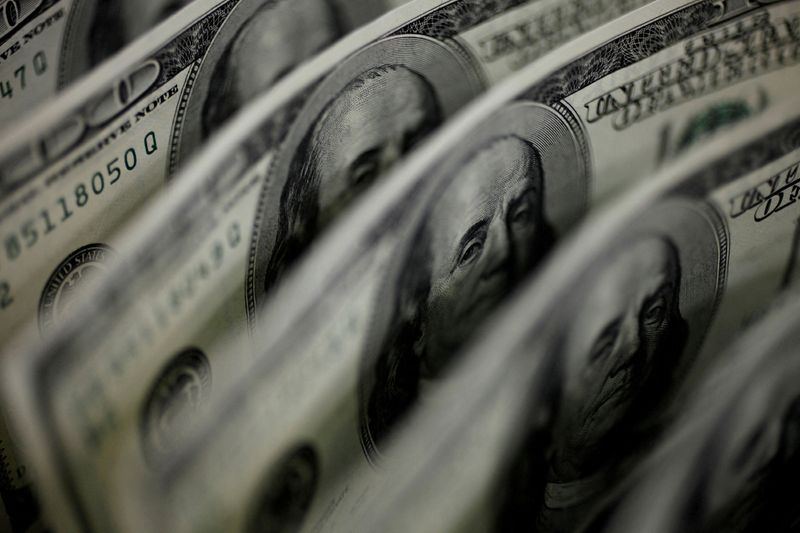Column: Undermining half the 30-year bond bull run: Mike Dolan
2022.07.15 09:23

FILE PHOTO: A picture illustration shows U.S. 100 dollar bank notes taken in Tokyo August 2, 2011. REUTERS/Yuriko Nakao
By Mike Dolan
LONDON (Reuters) – A more insular world economy will come at a high price if the era of global currency reserve building follows globalisation into reverse.
By some estimates, it could risk up to half the bond bull run of the past 30 years and usher in a protracted period of higher borrowing costs for all.
It doesn’t take much imagination to cook up a scare story on interest rates right now. Betting on higher borrowing costs right now hardly requires a doctorate in economics.
Inflation and interest rates are soaring post-pandemic, spurred further by the energy and commodity price shocks from the Ukraine invasion. The U.S. Federal Reserve is going into overdrive to rein in 40-year-high consumer price rises and the dollar exchange rate is electrified across the world.
Guessing how that pans out over the next 12 months or so requires the dexterity of everyone from Fed-watchers to Kremlinologists. While they work it out, financial asset prices are in retreat everywhere – with few places to hide.
But the eventual landing zone for the world economy and global asset prices depends significantly on the extent to which decades of globalisation of trade and investment, which underscored one of the most spectacular financial market booms in history by pooling world savings in ‘safe’ bonds, has already crested and is now in irreversible retreat.
Many economists are calling time on this period after four years of serial disruptions – from Washington’s trade wars under Donald Trump, to COVID lockdowns or health protectionism, and now a revival of Cold War politics and realignment of economic alliances following Russia’s attack on Ukraine.
The precise cost is a fuzzy concept. But some are taking a stab at it.
In their annual Equity-Gilt Study of global asset price research released this week, Barclays (LON:BARC) economists dwell heavily on the theme of ‘de-globalisation’ – especially the rethink of cross-border supply chains, investment and borrowing amid a rash of ‘on-shoring’, ‘near-shoring’ or even ‘friend-shoring’.
They paint an “era of instability” ahead as we wave goodbye to “The Great Moderation” of prices, wages and interest rates associated with years of expanding trade and access to world labour markets — and also a potential revival of macro volatility due to the return of clumsy inventory management following years of ‘just-in-time’ supply chains and shipping.
But in a special chapter on a possible peak in central banks’ hard currency reserves – one of the most obvious components of the so-called ‘global savings glut’ depressing borrowing rates for decades – the study puts a basis point estimate on the sort of risk ahead.
The piece, authored by Themistoklis Fiotakis, Marek Raczko and Sheryl Dong, details how reserve building was a function of decades of trade, investment and financial globalisation. Their model concluded that the banking of more than half of those hard cash reserves in U.S. government debt depressed 10-year Treasury yields by about 300 basis points since 1990.
That’s half the decline in 10-year yields that peaked close to 9% 32 years ago. And given the inexorable decline in long-term yields was a key factor in supporting credit and other interest-sensitive asset values over that period, then that sort of impact has been profound.
‘DECUMULATION’
The Barclays team riffed on the idea that the decision by Western governments to freeze some half of Russia’s central bank reserves as a sanction against Moscow’s invasion of Ukraine in February would mark a rethink of the safety and desirability of continuing decades of this steep reserve accumulation.
Much of the concern among investors over recent months centred on the idea that countries who felt their reserve hoards could be similarly impounded would engage in rapid diversification away from U.S. dollars, which still make up almost 60% of the near $13 trillion global stockpile.
But Barclays reckon there is no real viable alternative to the dollar as the dominant currency, other G10 countries also agreed to freeze Russian reserves anyhow and, instead, reserve managers may over time opt to rein in reserve building altogether – as renowned reserves expert Barry Eichengreen at University of California, Berkeley told Reuters in March.
An end to reserve building would have profound implications on how countries would manage their likely more volatile exchange rates and reliance on the Western world for export demand – as well as huge changes to how domestic companies would access overseas borrowing and inward investment.
But if greater use of capital controls and regional or hub-like trade links were adopted instead, then a gradual reduction of these savings pools may be in store – even if this rapidly compounds financial ‘de-globalisation’ in the process.
Focussed on direct impact on U.S. Treasury borrowing rates, the Barclays model suggests every $1 trillion increase in dollar FX reserves cuts 10-year yields by 55bp over the long run – half of which is visible in the first 10 months.
“While our model shows that the direction of yields would not have changed over time, it is possible that a large part of the decline could be linked to excess savings outside the U.S.,” the paper added. “And as such, reserve decumulation should have some impact on yields as well.”
Ending the reserve build is of course not the same as selling those assets. But even a halt in accumulation removes one outsize long-standing bid in ‘safe’ assets and could provide yet another nail in the coffin of the multi-decade bull market.
The author is editor-at-large for finance and markets at Reuters News. Any views expressed here are his own








